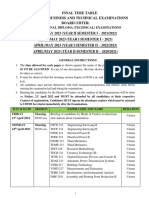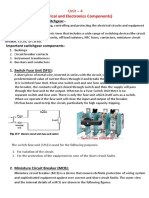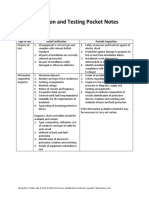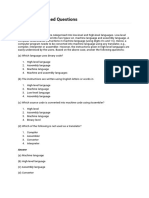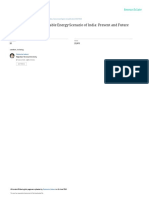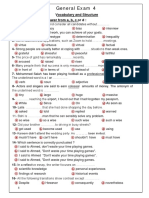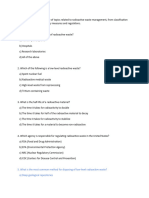©TVET Curriculum Development, Assessment and Certification Council July/August 2023
071306T4EEN
Electrical Engineering (Power Option) Level 6
ENG/OS/PO/CR/10/6
Demonstrate Understanding of Power Generation
July/August 2023
Time: 3hours
TVET CURRICULUM DEVELOPMENT, ASSESSMENT AND CERTIFICATION
COUNCIL (TVET CDACC) .c
om
t
tve
sy
ea
WRITTEN ASSESSMENT
3 HOURS
INSTRUCTIONS TO CANDIDATE:
This paper consists of TWO sections: A and B.
Answer ALL questions in sections A and three questions in B in the answer booklet
provided.
Marks for each question are indicated in brackets.
Do not write on this question paper.
Answer the questions in English.
This paper consists of four (4) printed pages.
Candidate should check the question paper to ascertain that all the pages are
printed as indicated and that no questions are missing.
Page 1 of 4
� ©TVET Curriculum Development, Assessment and Certification Council July/August 2023
SECTION A (40 MARKS)
Attempt all questions from this section
1. Define the term power generation (2 Marks)
2. Name FIVE sources of energy (5 Marks)
3. Name any FOUR types of generating station (4 Marks)
4. List any SIX-power generation stations in Kenya (6 Marks)
5. Define the term PPE as used at work and give two examples of PPEs commonly used
while working on a power generation station (4 Marks)
6. List FOUR reasons for using the grid system from power generation station (4 Marks)
7. List FOUR advantages of diesel power station as compared to hydro-power station
(4 Marks)
8. Name THREE electrical equipment of a hydro-electric power station (3 Marks)
9. Name FOUR main parts of Magneto hydrodynamic (MHD) generation
om (4 Marks)
10. Define the term thermal efficiency of a steam power station (2 Marks)
t.c
ve
11. Name TWO types water turbines mainly used in hydro-power plant (2 Marks)
t
sy
ea
Page 2 of 4
� ©TVET Curriculum Development, Assessment and Certification Council July/August 2023
SECTION B (60 MARKS)
Answer any THREE questions (All questions carry equal marks)
12. a) Describe the use of the following parts in a steam generating station.
i. Coal and ash handling plant
ii. Boiler
iii. Economizer
iv. Air preheater
v. Steam turbine
vi. Alternator (12 Marks)
b) KENGEN is planning to start a new hydro-electric power generation. You are provided
with the following data;
Catchment area = 5 × 10 9 𝑚2
Mean head, 𝐻 = 30 𝑚 om
Annual rainfall, 𝐹 = 1 · 25 𝑚
.c
t
ve
Yield factor, 𝐾 = 80 %
t
sy
ea
Overall efficiency, 𝜂 𝑜𝑣𝑒𝑟𝑎𝑙𝑙 = 70 %
Calculate the average power in kW that can be generated and determine the appropriate
rating in kW of generators to be installed putting in consideration, load factor is 40%.
(8 Marks)
13. a) Using a labelled schematic arrangement of hydro-electric power station, explain the
function of the following parts.
i. Dam
ii. Spillways
iii. Surge tank
iv. Penstock (12 Marks)
b) A steam power station spends, Ksh 3,000,000 per year for coal used in the station. The
coal has a calorific value of 5000 Kcal/kg and cost Ksh 300 per ton. If the station has a
thermal efficiency of 33% and electrical of 90%, find the average load on the station.
(8 Marks)
14. a) Describe the following plant auxiliaries of a diesel power station.
i. Fuel supply system.
Page 3 of 4
� ©TVET Curriculum Development, Assessment and Certification Council July/August 2023
ii. Air intake system.
iii. Cooling system.
iv. Lubricating system. (12 Marks)
b) Kenya expects to start generating electricity from nuclear power by the year 2030. As an
engineer delegated in planning, explain four factors considered when selecting the site
for a nuclear power station. (8 Marks)
15. a) Having trained as engineer, you have been appointed to explain to trainees how gas
generation station works, using a well labelled schematic diagram explain the main parts
of the gas generation station. (12 Marks)
b) Being an engineer in energy sector you are invited for power generation seminar. You
have been delegated to talk about renewable power generation. Highlight five advantages
and three disadvantages of solar energy power generation. (8 Marks)
om
t.c
ve
t
sy
ea
THIS IS THE LAST PRINTED PAGE
Page 4 of 4

























